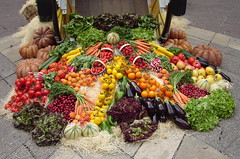 Image by val'sphotos via Flickr
Image by val'sphotos via FlickrWe've covered coupons and sales, but there's so much more to saving money on groceries and everyday items.
We'll cover the basics now (and stick to food items), but look for future articles expanding on the various tips listed here.
- A couple weeks back, Jane posted a very helpful article about where to find inexpensive meat, particularly chicken. However, if you really want to save money and help the environment (see footnote #1 on the Jan. 16 post), go vegetarian--or better yet, vegan. If you're not ready to go all the way just yet, start small and work your way to your goal. Eliminate red meat first (including pork), then poultry, seafood, etc. The process is easiest when you take it in slow steps, and it's perfectly fine to spend 6 months on each step. PETA's GoVeg.com is a great resource for learning more about vegetarianism and how it can help save your body, your wallet, and the planet.
Beans, legumes, tofu and other soy products, textured vegetable protein (sounds gross but tastes good), vegan cheese, powdered egg replacer (amazing for baking) and wheat gluten are all tasty, economical replacement sources of protein. Get your soymilk with added calcium, but check the exact daily requirements. Many vegans especially need to take a daily calcium supplement, though your daily multivitamin may take care of that for you. - Buy in bulk whenever practical. Dried beans from the bulk bins are almost always way cheaper than canned beans, and they make for a lighter load in your grocery bag. Rice, noodles, quinoa, and other grains are also best bought in bulk. Just make sure you store them properly. Weevils are not veggie friendly. ;)
- Stick with store brands/generic brands whenever possible. But don't feel the need to sacrifice taste or nutritional content for it.
- Buy ingredients for meals, rather than pre-made meals. Yes, it's less convenient, but it's usually much healthier and cheaper. When you make it yourself, you can be sure you know exactly what's going in it and what sort of standards it's prepared at. If you're trying to keep tabs on exact nutritional content or calorie-counting, preparing your own meals does make figuring their exact nutritional content a bit more involved than just reading the box after you pop it in the microwave, but it's easily worth the extra math.
- Speaking of ingredients, buy ones that are inexpensive and versatile and that store well. The idea is to be able to buy your ingredients in bulk, thereby saving money, and use them in many different recipes. Staple items like flour (don't neglect the whole wheat variety!), sugar, rice (go for the stuff with the highest fiber content), pasta (again, don't neglect the whole wheat stuff), various Asian noodles, potatoes, onions, frozen and canned fruit and vegetables1, and beans all fall into this category.
- Make sure you're actually getting the deal you think you're getting. When you're at the store, ignore the item prices. That's right, ignore them; they can be misleading. Instead, look for the per unit price (per ounce, per 100, etc.). If you're trying to see which brand of an item is cheaper, you can compare these to find which is the better deal.
- Make big meals, enough for leftovers. This saves time and effort (and keeps you from ordering out) for those times when you're too tired or busy to cook. This works especially well with soup or other one-dish meals; you can make a giant pot, set aside some for leftovers, and freeze the remainder. (No matter how good something is, you probably don't want to eat it every day for a fortnight.) Alternate leftovers with sandwiches, etc., to take to work to keep from spending $7 on lunch every day.
- Ditch empty foods. Stop wasting your money on junk food and empty calories--soda, chips, snack crackers, and maybe the toughest one to cut--alcohol. That said, if you want to have a drink now and then, you're much better off buying alcohol at the store and making your own drinks than going to the bar.
- Stop buying bottled water. All those bottles are bad for the environment (yes, even if you recycle them), and you're wasting your money anyway. In most cities in the U.S., tap water is just as healthful as bottled water, plus it has Fluoride, which many bottled waters do not. If you're really paranoid about your water quality, get a Brita pitcher. You can get super-cheap refill cartridges from sellers on Ebay, Amazon, etc. I've even found a boxful on Craigslist for $5. Also, hopefully this doesn't come as a surprise, but a lot of bottled water is just fancy tap water (Dasani, Aquafina, and others).2
- If you drink coffee, brew it at home and take it with you in a travel mug or thermos. Better yet, drink the free work coffee (unless, of course, it's really gross like my work's coffee). Alternatively, you could pick up a cheap little coffee maker at a garage sale or thrift store and keep it at work. If you drink tea, buy bags at the grocery, keep a mug at work, and brew it there.
- Speaking of free stuff from work, don't forget to take full advantage of free food for meetings, special occasions, etc. At my place of business, whenever there's leftover food from a meeting, we put it in the department kitchen for whoever wants it. I've gotten many a free lunch that way.
- A more time-intensive (and much more rewarding, I would say) way to acquire fresh, organic produce on the cheap is to grow it yourself. Even if you live in a high-rise apartment building, you can have your own garden; you'd be surprised what you can grow in containers inside or on a sunny balcony. Plus, you don't have to worry about pesky (but oh, so cute) bunnies and such nibbling at your lettuce. New to gardening? No worries. We'll be posting a more in-depth article about vegetable and herb gardening shortly.
[1] Contrary to popular belief, frozen and canned vegetables/fruit are usually no less nutritious than fresh, provided of course, that no salt or sugar has been added. For more info, see this article by Nutritionist Jane Harrison.
[2] For more info on drinking water, see the NRDC's Bottled Water FAQ
this article in Fast Company, and this article at Medical News Today.
Update: Thanks to WiseBread for including this post in the Carnival of Pecuniary Delights No. 2: Saving Money Edition.


![Reblog this post [with Zemanta]](http://img.zemanta.com/reblog_e.png?x-id=61d4caf2-caa1-4f62-9895-239864572177)



























1 comments:
Post a Comment